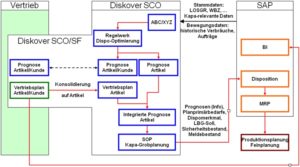Low-cost sales planning leads to better production supply
By Anja Hartmann, ASK Chemicals GmbH, and Dr. Bernd Reineke

Rising customer demand coupled with a simultaneous shortage of raw materials on the markets presented the supply chain of ASK-Chemicals, one of the world’s largest suppliers of foundry chemicals, with a major challenge in the supply of raw materials for production. During the financial crisis, capacities were reduced in many places, which subsequently led to supply bottlenecks as incoming orders increased. The increase in sales hit most companies unprepared and the processes were not designed for such short-term fluctuations in demand. ASK was able to respond well to the market situation, as the sales and demand planning process had just been optimized with the support of management consultants Abels & Kemmner. The result today is largely automated and integrated sales and demand planning processes that lead to better availability despite minimized effort.
ASK Chemicals GmbH is the preferred and innovative partner of the global foundry industry. Product-efficient problem solutions, tailor-made products and above-average technical service worldwide on site characterize the innovative company, which manufactures foundry chemicals and synthetic resins, among other things. The automotive industry and the mechanical and plant engineering sector in particular benefit from this.
Strong sales growth, lack of process adaptation
The years before the financial crisis were characterized by a sharp rise in sales and a corresponding increase in the customer base. As a result, the old structures for planning and controlling procurement and production were no longer suitable. However, there was no time to optimize the processes and develop suitable methods. A typical picture for rapidly growing companies. To remedy the situation, ASK-Chemicals commissioned the consulting firm Abels & Kemmner GmbH to develop the new structures that had become necessary and to introduce suitable methods and tools.
Distinguishing symptoms and causes
In the past, processes at ASK-Chemicals were characterized by ad hoc planning and control actions in order to be able to serve short-term customer orders. However, the high level of effort and coordination required to fine-tune production was not caused by a lack of planning expertise, which could be improved by a detailed planning tool. During the initial analyses, it became clear that these were more likely to be symptoms caused by higher-level planning. Current market developments were not consistently incorporated into the planning process. A lack of forecasts and insufficient security to cushion sales fluctuations led to the symptoms described above. It was therefore decided to fundamentally restructure the planning process and support it with suitable software.
Achieve maximum benefit with minimum effort
The aim of the new process was to keep the workload as low as possible while still achieving a good planning result. After all, the company did not want to create too much overhead for this additional planning, but wanted to remain as lean as possible. Abels & Kemmner’s proposal to determine future requirements as far as possible using statistical forecasts, i.e. to use software to automatically plan all products to be scheduled, was therefore a very good idea. The statistical forecasts should only be supplemented with sales information if deviations from the forecasts are to be expected. This means that the sales planner’s only task is to plan exceptions – which saves a lot of time and effort. That sounds good and is possible, but requires a few basic conditions.
Planning away from standardized forecasts
As there is no rule without exception, it goes without saying that, in addition to automated scheduling, cases that cannot be predicted in a standardized way must also be taken into account. Every sales manager must therefore be able to enter promotions, new customer listings or even discontinuations by existing customers, for example. Other events that need to be planned manually are new products or product variants that cannot be forecast due to a lack of historical values, as well as discontinued products for which statistical forecasts are no longer calculated.
Requirements for the software
In order to carry out such analyses, software is required that makes it easy for the sales department to identify the exceptions. The software must therefore be able to describe the planning not only at component parts list level but also at the customer’s item level. Mathematically and statistically, the software should also be able to automatically determine the most suitable forecasting and safety stock procedures in order to achieve the desired delivery readiness with the lowest possible stock levels. It is not enough to use just any forecasting method, but rather the forecasting method that delivers the optimum result should be used. This is a small but crucial difference that is all too often ignored in practice because there is often a lack of know-how about the different processes and the ERP systems used usually do not allow such variant tests.
How high is the standardization?
In practice, it became apparent that the proportion of automatically predicted articles is very high. For example, a number of items, particularly in the area of raw materials, are planned based on consumption using reorder point procedures. With the help of the sales and forecast figures, new reorder points are always determined and transferred to the SAP system via standard BAPIs. Other articles are planned with planned independent requirements. For these articles, the pre-planning values are transferred to the SAP system with the correct strategy group. The few exceptions can be conveniently planned by the sales department from anywhere in the world. The advantage of the solution lies not only in the resource-saving planning, but also in the optimum planning quality. This results from the optimization algorithms used in the simulation. This involves recreating the planning situation of the past and applying alternative methods for determining safety stocks, forecasts and scheduling as well as their parameters.
Arguments in favor of DISKOVER SCO:
- Clear interface between the systems
- consistent solution
- Clear division into planning domain (Diskover SCO) and execution domain (implementation of planning à MRP and MRP by SAP)
- Few system breaks
- Minimization of operating expenses
- Use of the optimization algorithms of Diskover SCO
- Use of Diskover SCO leads to
- high flexibility and
- Less complex implementation than with SAP/SOP
- Significantly higher planning quality
- Consistent application of the regulations across all material stages
→ Optimization of MRP parameters also for semi-finished products and raw materials
Spoilt for choice
There are not many software tools available on the market worldwide that support ERP systems in optimizing planning and scheduling. DISKOVER SCO from SCT GmbH was chosen from those available, as this system was the most convincing in terms of both programming technology and methodological expertise. The software has been developed using the latest Java technologies and can therefore be quickly and easily adapted to new requirements. At the touch of a button, the methods offered can also be reduced to the possibilities of the SAP system used, which makes both the high compatibility of DISKOVER SCO with SAP and the high technical method competence itself easily visible, because a simple click reveals extended methods that lead to even better results in certain planning cases. If these special functions are not used, the data obtained from the SAP system via standard interfaces is analyzed in the DISKOVER SCO integrated set of rules and returned to the SAP system with updated values. DISKOVER SCO determines how the articles are to be set and how the sales figures are to be incorporated into planning and scheduling.

Using the DISKOVER module ‘Sales Forecast’, sales staff can record the exceptions at article/customer level as described above and thus incorporate them into planning. Regardless of location, data can be recorded worldwide and processed centrally. In the consolidated planning view, the additional requirements or sales corrections are visible and transferred to the requirements calculation. The end-to-end planning chain is completed by transferring the resulting planning figures and recalculated planning parameters (e.g. reorder and safety stocks) to the SAP system.
Further information on this topic can be found here:
- 11 best practice rules for efficient sales forecasting

